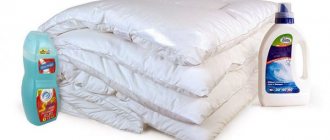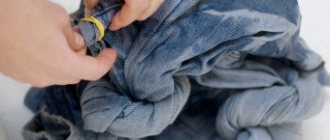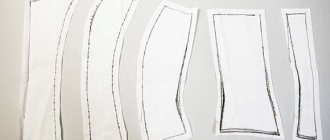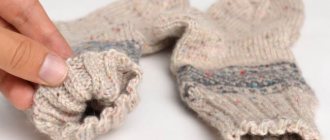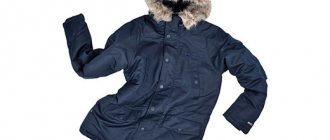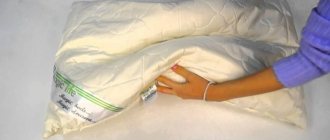What to do to prevent woolen items from itching
It is important to know that a thing “bites” because of its structure.
Like human hair, wool tends to split, forming small lint along the edges of the thread, which irritates the skin. Scientists claim that the “biting” thing is good for health, but not everyone is ready to put up with discomfort for medicinal purposes.
Therefore, many fashionistas and fashionistas who prefer warm clothes made of wool try by any means to soften the prickly purchase. There are several ways to make clothes softer.
Are all woolen items itchy?
What else can you do to prevent your sweater from itching? The best thing to do is buy something made from the right material.
The most unpleasant in terms of causticity is sheep's hair. Covered with small scales, it scratches the skin unpleasantly. It is better for the animal to be cut, then the hair will be even and the thread will be more manageable and almost thornless. If the yarn is made from the wool of an animal that has been combed, then it will “bite.”
For lovers of woolen clothing, we recommend buying items knitted from alpaca wool. The material is expensive, but the question of how to wear a scratchy sweater will most likely not arise. Also pay attention to how the yarn is made.
Powder for woolen items
You can make wool clothes soft by using a special powder and fabric softener. The most common of them are Laska and Lenore. It is better to purchase the liquid version of the product, it works better on the fabric and does not leave streaks.
You can use special softeners for washing machines and for hand washing; you need to choose a method based on the recommendations on the tag. During hand washing, the fabric deteriorates less and the risk of distortion is reduced.
Conditioner and powder soften the fabric, fixing the lint that has come out tightly to the thread itself. The effect of the product is not long-lasting, but it tends to accumulate. With each wash the item will become a little softer.
Shampoo and hair conditioner
To make clothes softer, it is not necessary to purchase special products for woolen items. You can use shampoo or hair conditioner (preferably both), which we use to wash our hair. It is advisable that they be for dry and split ends, then the effect will be stronger. Shampoo for long-haired animals is also good for softening.
Shampoo and conditioner, or maybe 2 in 1, act like powder. They are able to soften the hair, making it a single whole, and thanks to the fragrances, your clothes will not only be more pleasant to the body, but will also smell delicious.
To soften wool items, wash them in cool water and shampoo. Squeeze a little and apply the balm evenly on both sides. Leave the item for 5 minutes, then rinse off the balm and send the clothes to dry.
To prevent a woolen item from changing shape and stretching, it must be dried only in a horizontal position.
Effective methods for eliminating scratchiness and softening wool products: step-by-step instructions
You can make wearing your favorite warm product comfortable and enjoyable, freeing it from excessive rigidity and “bitingness,” using various means that, as a rule, can be found in any housewife’s home.
Methods for softening an object at home are simple and safe: if used correctly and in compliance with all proportions, they will not harm the material and will not change the color of even snow-white things.
Lemon juice is very effective at softening the material, making it more elastic and less rigid. To implement this method, you will need several lemons, gauze cloth and a steaming iron or just a steamer:
- lay out and carefully straighten the product on a horizontal surface;
- squeeze the juice from a couple of lemons and moisten a gauze cloth with the resulting liquid;
- cover the product with a gauze cloth soaked in lemon juice and leave for 30 minutes;
- After half an hour, steam the item using a steam generator.
Glycerin, which can be found in any pharmacy, is considered one of the most effective means for softening tissue stiffness:
Dishwashing liquid
Dishwashing detergent has a fairly wide range of actions, including eliminating the “biting” of woolen material:
- wet the item with warm water , making sure that there is not a single dry area left;
- take a small amount of dishwashing liquid and whip up foam . The exact amount of liquid depends on the size of the item. For average items, a couple of handfuls of detergent are usually enough;
- cover the entire product with foam , thoroughly soaping it on all sides;
- leave the item for 1.5-2 hours , then rinse thoroughly with cool water.
Mustard powder
Mustard powder, which dissolves in water, can be successfully used for this purpose. This method is suitable for softening even the toughest and prickly wool items:
- dilute 3-4 tablespoons of powdered mustard in warm water , stirring the liquid thoroughly;
- place the “biting” thing in a container with mustard mixture for two hours;
- rinse the item until the mustard composition is completely washed away , then dry it horizontally on a towel.
By exposure to cold temperature
Cold has a positive effect on wool fibers, making them smoother and, as a result, soft and manageable. In addition, this method is the simplest and does not require anything other than providing a cold temperature for 10-12 hours:
- put the item in the freezer of the refrigerator overnight or leave it in the snow on an open loggia, balcony or in the courtyard of the house. Cold air will eliminate hardness and make the product pleasant to the body;
- after 10-12 hours, the item should be brought into a warm place, carefully straightening out all areas , and hung on a hanger.
Shampoo
Hair shampoo will not only help to carefully clean the item of dirt, but also restore its pleasant softness. For light and snow-white products, it is recommended to choose colorless shampoos:
- gently wash the product in warm water with shampoo , being careful not to stretch or injure the material;
- rinse the item in cool water and dry away from direct sunlight and heaters.
It is advisable to choose a shampoo for children or natural and ecological, without aggressive chemical components in the composition.
Steaming wool
Another way to make wool “thorn” soft is to steam it. To do this you will need: an iron or steam generator, a cloth (the size of the item being processed or larger) and citric acid. Lemon tends to soften things, and steam only enhances the effect.
To prevent wool items from itching:
- Place the clothes on the ironing board.
- Set the iron to the “wool” setting, if there is one, or just to a high temperature, but not maximum.
- Prepare a lemon solution (1 pinch per 1 liter of water).
- Dip the cloth into the solution.
- Place the damp cloth on the woolen product.
Now everything is ready, you can start the steaming process. Gently, without pressing too hard, go over the entire fabric. If you press hard, the item may stretch out, so everything needs to be done gently and with light movements. Having finished on one side, wet the fabric again and begin working on the second side of the product. When using a steam generator, the process of preparing clothes and steaming them does not change.
Mustard powder
This method, which makes it possible to make things less prickly, was used by our grandmothers long before the invention of special powders. Mustard softens the fibers, and the material becomes noticeably softer and more pleasant to the touch.
Using mustard powder to soften wool is very simple. Add 2 tbsp. l. mustard into a bowl of warm water and place the woolen product there. Leave it in the solution for an hour, then rinse thoroughly. Drain the mustard solution and rinse the clothes thoroughly. Squeeze lightly and set aside to dry.
A solution of vinegar and table salt
Vinegar perfectly softens wool fabric, making it soft and pleasant to the body. To prepare a vinegar-based solution, you need to mix the main ingredient with salt in equal proportions. For 5 liters of cool water, 1 tsp is enough. vinegar and table salt. If there is no vinegar in the house, you can replace it with citric acid.
For better results, the product should not only be rinsed in the solution, but also left to soak for 30 minutes. Since vinegar has a strong smell, even though there is only a small amount of it, it will take quite a long time to rinse the item after “bathing.” After washing the fabric under running water and getting rid of the smell, the product can be hung to dry.
Exposure to cold temperatures
Perhaps the most original way to make wool not prickly, but soft, is to expose it to cold temperatures, in other words, to freeze it. With this method, the lint on the thread freezes and falls off, so the clothes become softer.
Since in city apartments you can’t hang things out the window, unless on an unglazed balcony, and winter is not eternal, a freezer is usually used for this method. In addition to the freezer, we will need a plastic bag.
Place the damp woolen item in a bag and place it in the freezer for a day. After taking out the product, let it defrost, then rinse it in cool water. It is better to rinse with the addition of fabric softeners presented here.
Unfortunately, all of the above methods are only suitable for slightly itchy wool. If the material itches a lot, then there is nothing you can do about it, all you have to do is endure it or wear something softer under the bottom of your woolen clothes. Therefore, if you want to purchase something made of wool, carefully look at the composition, the manufacturer, and don’t forget to touch it (it’s best to touch it to your face).
It is worth remembering that the prickliest wool is sheep's wool. As a rule, hand knitting is more rigid than industrial knitting. When purchasing, it is better to choose products not made from 100% wool, but with impurities.
Recipe for getting rid of itchy fur
Greetings to all needlewomen!
I want to share with you a recipe for getting rid of the itchiness of woolen items! I love prickly socks, BUT only socks. Everything else - be kind to me, softer, gentler, and silkier! Has it ever happened to you that your favorite warm sweater, scarf and hat are sent into exile because they hurt! Are you afraid of purchasing new things made from natural wool because of the prickliness?
Let's see WHY: 1. wool is hair, and the tingling sensation is felt primarily because of the scales on the hair. Those. depends on the breed of the animal: certain breeds of sheep and camels have more scaly hairs!
2. The method of obtaining raw materials to obtain yarn is also important: shearing is cheaper and easier, but the fibers have sharp ends. And combing is a more expensive method, but the fiber is more delicate!
3. The type of raw material is also important: down, undercoat and long-fiber wool (like merino wool) are the most delicate and soft. Cashmere never itches at all!
Thus, the prickliness of the yarn appears both from the sharp ends of the sheared wool (and not combed), and from the characteristics of the wool itself of different breeds of sheep: the hair scales, split ends, and simply shorter and thicker hairs used for spinning are prickly.
Those. To reduce the prickliness, you need to soften the wool hairs in the yarn or make sure that the split ends and hard scales fall off!
I get a lot of orders for wool knitting, and often people ask what to do to reduce the scratchiness, or even ask me to do something
- Share
Using my favorite and very warm wool scarf as an example, I’ll show you what I do to stop itching. There are several recipes for a solution for soaking: 1) A solution of vinegar with water - 1 teaspoon per 10 liters of water for soaking for 20-30 minutes after washing, then rinse thoroughly and let dry 2) Mustard powder: stir 1-2 tablespoons of powder in a basin of hot water; wait until the water cools down and soak the product for a couple of hours, then rinse and dry 3) Glycerin: dissolve 1 teaspoon per liter of water, soak the product for 20-30 minutes, rinse thoroughly and dry
Sometimes it is enough to soak the product in an appropriate solution, rinse and dry the product. But I often have to take more drastic measures to really get rid of the barbs. Especially regarding children's things! In this case, immediately after soaking in the solution, I pack the product, lightly wrung out of water, into a sealed bag and put it in the freezer overnight or for a day. Then I take it out, wait for it to thaw on its own, rinse it thoroughly, and dry it flat. Some particularly prickly yarns require the wet freeze to be repeated several times. For example, my scarf took 2 uses - and now I can happily wear it not only over my coat!
Even loops and warm scarves to you! Your Alexandra
Tricks for housewives to prevent sweaters from itching
It also happens that not a single method gave the expected result, but together they worked as expected. Tip from this series:
- wash in shampoo;
- rinse with conditioner;
- squeeze lightly, put in a bag and put in the refrigerator for a couple of hours;
- remove, defrost by natural drying;
- spread on a horizontal surface;
- During the drying process, lightly shake the sweater several times, fluffing the wool.
- Recommended for mohair and other long pile items.
Well, and a completely extreme case - sewing thin strips of fabric from the wrong side of the sweater at the neck and in the cuff area . It is worth noting that this is not so easy to do: the stitches must be made invisible, and the parts of the product must not be deformed.
Reasons why woolen items are very scratchy
A slight tingling sensation is a natural characteristic of the coat.
The reasons for this unpleasant property are:
- wool fiber has loose ends, which cause an unpleasant tingling sensation;
- Method of obtaining wool: shearing or combing. Haircut, unlike combing, is a less labor-intensive method of obtaining, but the fibers are rough and have fluffy ends that cause tingling. When combing an animal, guard hairs do not get into the raw material, and the items turn out to be tender, soft, and pleasant to the body;
- cashmere, mohair, alpaca, camel wool, merino wool - they all have different thread densities and degrees of thorniness.
Items made from cashmere and merino never itch. Products made from dog and camel hair have a pronounced tingling effect.
Why do things prick?
The sweater is made from animal hair fibers, which is why people feel a tingling sensation on their skin when they wear it. Various types of fiber are used in the manufacture of models.
Advantages of using wool in the production of products:
- the model does not wrinkle and retains its shape;
- natural fiber repels dirt;
- absorption of unpleasant odors and moisture is minimal;
- reliably protects from the wind;
- keeps warm.
The only drawback is the thorniness of the fiber.
There are parameters by which you can determine how much the wool fibers will prick:
- Pile length. The smoother and longer they are, the smoother and straighter the resulting fiber will be.
- Thinness of hair. If the pile is thin, then the yarn will be pleasant and delicate.
- Method of obtaining raw materials. When shearing an animal, a less thorny thread is formed. If the method of combing the undercoat is used, the resulting fiber is curly and more uncomfortable.
- Manufacturer of the model. If the manufacturer is decent, then high-quality, uniform pile is used in the work. Otherwise, during the production of the product, smooth and hard raw materials are twisted, which results in a more prickly sweater.
It is important to remember that the feeling of tingling hair fibers after purchasing a new product is inevitable. However, this problem can be avoided by using small tricks when washing woolen items.
How to prevent woolen items from itching?
Scientists claim that the tingling effect that some types of wool have has a beneficial effect on human health. It stimulates nerve endings and increases blood circulation. Many people do not agree to tolerate discomfort. For them, there are many methods with which you can get rid of the causticity of woolen products.
6 folk remedies
Both modern means and ancient recipes, tested by many years of experience, will help make clothes softer.
Special washing powders and gels
Many washing powders and gels, for example, “Laska”, “Lenor” perfectly soften the fabric and smooth out protruding hairs. The effect of their use does not last long, so it is necessary to use the products after each wash in accordance with the instructions on the package.
Conditioners and gels are more suitable for wool than powders. They perfectly soften fibers without damaging the structure of things.
Shampoo and hair conditioner
These cosmetics soften wool fibers well. After using them, things will stop pricking and will smell nice.
How to wash woolen items without itching?
As mentioned above, both modern and folk remedies tested by many years of experience will help make clothes soft. There is another method, the most effective, according to reviews from many housewives. We use shampoo to wash our hair; it is logical to assume that this method would be more than appropriate for woolen items. First, wash the sweater in warm water and shampoo. Apply balm to it, after 5 minutes, rinse, dry in the standard way. This recipe is very easy to remember; wash it the same way you wash your hair. Every housewife knows which shampoo and conditioner makes her hair soft and silky. Use these products for your favorite warm clothes, if you don’t mind, of course.
We hope you got the answer to the question: what should you do to prevent the sweater from itching, what should you wash it with so that it becomes soft? Let's summarize. According to reviews from housewives who have tried these products, the most effective is washing with shampoo or special products. Other methods have a cumulative effect, that is, they do not work the first time. Use dish soap and freezer carefully to soften items, especially for clothes made from delicate yarns. Don't forget that mustard can only be used on dark-colored clothing. If you are just going to buy warm woolen clothes, pay attention not only to the appearance. The quality of the material and the reputation of the manufacturer are very important. If you take this into account when purchasing, then you won’t need the rest of the tips. We hope that our recipes will be useful to you. No more getting frustrated if your new sweater itches. Because now you know what to do!
Please rate how useful this article was to you! (No ratings yet)
Yandex recommends - the best articles on the site
You may also be interested in
- Top 15 ways to quickly dry things after...
- Top 20 ways to remove paint from clothes at home...
- Instructions: how to properly wash a cashmere sweater...
- Instructions: how to make terry towels soft and…
- How to do general cleaning in an apartment in an apartment...
- The item shrank after washing, how to return it to its original size -...
- TOP 15 step-by-step ways to fold correctly...
- 11 proven ways to properly clean...
- Top 20 ways to wash windows without streaks and for a long time...
- Instructions: how to properly wash a wool sweater in...
- What to do if your sweater stretches? How to recover?
- 11 Effective Ways to Soften a Leather Jacket in...
How to make a wool item soft the first time you use it - an express method?
To prevent a new jacket from pricking while being worn, before the first use it must be softened - washed in water with added shampoo, rinsed using a special softening gel, lightly squeezed, and placed in the freezer for two hours. Then remove, defrost and dry.
During the drying process, it is recommended to shake the product in order to fluff the wool.
After such procedures, the new sweater will become soft and will not cause itching or discomfort to its owner.
Can a scratchy sweater be softened in the freezer?
Those who studied physics well at school know that water expands at subzero temperatures and contracts at positive temperatures. Thanks to this feature, many centuries ago, women discovered that it is best to wash down and wool items in winter, as they become softer, more delicate and do not itch at all, as if they were washed in the warm season.
Can a scratchy sweater be softened in the freezer?
So, detailed instructions on how to make any woolen or downy item soft using frost or a freezer:
- We wash and rinse using any of the methods described above;
- We throw it onto the net and let the water drain, but the fabric itself should remain damp;
- Place the item in a bag and place it in the freezer or in the cold for several hours;
- Take it out and let it defrost completely, shake it and lay it out on a horizontal surface to dry. Shake during drying to help fluff up the fabric.
How to soften a woolen item?
In order to make a wool sweater softer, you should use traditional methods or purchase special products. You can treat the item with steam or expose it to low temperatures (below 0°C). Skilled housewives can try to remake a sweater or other product by unraveling the yarn and, after steaming, mixing it with cotton or silk threads.
Exposure to cold
One of the simplest methods of getting rid of excessive prickly wool is freezing. In winter, the product can be hung on the balcony or outside and left for a day. In summer, spring and autumn you can use the freezer. To do this, the item must be placed in a plastic bag, carefully folded, and placed in the freezer for 24 hours. After this procedure, the protruding hairs will break off, and the sweater will not prick so much. After defrosting, the item must be rinsed in cool water.
Steam treatment
When exposed to steam, wool softens, so it makes sense to get a steam generator or an iron with a steam function. Water is poured into the steam generator, it is connected to the power supply and the product is processed for 2-3 minutes. When using an iron, you should avoid direct contact of its sole with the surface of the woolen item. It is necessary to iron the product through a damp cloth or gauze. To enhance the effect, the fabric is moistened in a lemon solution (1/4 teaspoon of citric acid per 0.5 liter of water). Lemon will additionally soften the fabric and eliminate prickliness.
Special detergents for washing woolen products
Woolen items should be washed by hand. To do this, pour water at a temperature of 30–36°C into a basin, dissolve a small amount of gel and place a woolen item there. Water should completely cover the product. It should be left in the basin for an hour. After the allotted time, it is necessary to wash off any existing dirt and rinse the sweater until the detergent is completely washed out. The item should be dried in a horizontal position, laying it on a terry towel, which must be changed periodically.
Hair care products
The structure of wool is similar to that of human hair, so hair care products can be used to treat such products. It is best to purchase shampoo and conditioner for split ends, dry hair, then the effect will be more noticeable.
For washing, use shampoo, which is dissolved in cool water. Place a woolen product in water, leave for a few minutes, after which the dirt is carefully washed off. After this, the item is rinsed until the water becomes clear. Then the sweater is lightly wrung out and balm is applied to its surface and left for 5 minutes. Finally, the product is rinsed well and dried in a horizontal position away from heating devices and ultraviolet rays.
Folk ways to soften wool
The oldest method of softening wool, which our great-grandmothers used, is the use of mustard powder. It was used when chemicals had not yet been invented. Take 2 tbsp into a basin of warm water. l. mustard powder, stir well and dip the woolen product into the solution. Leave for an hour. After this, the item must be washed and rinsed. It must be said that mustard powder has a yellow tint, so this method is not suitable for washing white clothes. Alternative means are:
- Saline solution with vinegar. For 10 liters of water take 2 tsp. table vinegar and table salt, stir. The product can simply be rinsed in water and left for half an hour to enhance the effect. After such a procedure, a vinegar smell may remain, which can be eliminated with soda or ammonia. If there is no specific smell, you can immediately lay the product on a terry cloth to dry.
- Glycerol. A more gentle method that does not leave an unpleasant odor. To soften the wool, the product is dipped into a basin with a glycerin solution (5 liters of water, 5 teaspoons of glycerin) and left for an hour. Then rinse and dry in a horizontal position.
- Soda with ammonia. A combination of ammonia and baking soda can soften the prickly tissue. To make a solution, take 0.5 tsp per 5 liters of water. soda and 3 drops of ammonia, mix. The item must be placed in liquid for 40 minutes, then rinsed and dried.
Ways to eliminate the scratchiness of a sweater
All of the following methods and methods of influencing the structure of wool villi have been tested by the people and have long proven their effectiveness. For some things one method is suitable, for others another. So what to do? Here are some general tips for caring for natural wool items:
- wash such items only with special detergents; if necessary, you can use hair shampoo or conditioner;
- Wool loves hand washing. Even on delicate mode, your favorite sweater can become deformed. Use it only in emergency situations;
- wring out the washed item without twisting , very carefully;
- always dry flat;
- Several times during this time, lightly move or shake the item to fluff up the fur.
Important! Conventional fabric washing powder destroys the structure of the pile and is difficult to rinse. Avoid using it on woolen items.
So, to eliminate the harshness, you need to try a special wool softener. If there is no result, we begin to search for “our” method.
We use mustard
This method has been used by people for a long time. We will need 1-2 tablespoons of mustard powder. It's quite simple:
- dissolve dry ingredients in a bowl of hot water;
- cool the resulting solution to a temperature of ≈ 40 degrees;
- lower the product there and let it stand for several hours;
- rinse and dry.
Apply hair conditioner
The method is simple and accessible. Products designed for cleansing hair will also work best for wool:
- We wash the sweater in warm water, use hair shampoo as a special powder;
- We rinse several times with the addition of hair conditioner from the same series (if you don’t have it, you can take a balm).
Important! Shampoo and then conditioner will make the hair structure softer and fluffier.
Lemon against tartness
One of the most time-consuming methods:
- squeeze the juice out of three or four lemons;
- moisten a cotton cloth with it;
- spread the material on the wrong side of the sweater;
- leave in this position for an hour (half an hour on each side);
- then treat with a steam generator.
Glycerin for softness
This method is very simple: you need a teaspoon of glycerin per liter of water. The woolen item is soaked in the resulting composition for half an hour. It is clear that you still need to buy glycerin at the pharmacy, even though it is inexpensive. And you can’t soak a sweater in a liter of water; you need to select it by volume on the spot. After the procedure, rinse the sweater thoroughly in several waters.
Is all the wool itchy?
Products made from 100% wool usually have strong scratchiness. This is usually camel or sheep wool. Hand-knitted items are often endowed with this unpleasant property compared to industrially produced products. When choosing a wool sweater, you should feel it thoroughly and make sure there are no protruding hairs. The softest products are those made from mohair, cashmere, angora, and alpaca. The impurities also make wool items more comfortable to wear.

